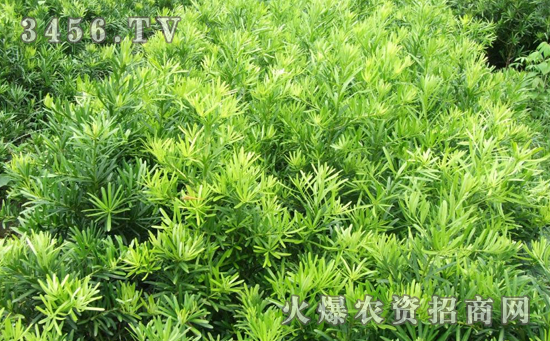Control methods of Leaf Blight of Pinus elliottii
Greenhouse in South China, Southwest China, Central China, East China and North China.
[symptoms] occur on the leaves of Luohan pine. In the early stage, the disease spot mostly occurs at the leaf tip, yellow withered spot, the disease boundary is obvious, in the later stage, the disease spot is grayish yellow, dry, and there are black grains on it.
[occurrence regularity] the pathogen is a weak parasite and often infects plants with poor development and weak growth. it can occur all the year round under greenhouse conditions, and the disease is more serious after autumn during open-air maintenance.
The causes of Leaf Blight of Luohan Pine and the Control methods of Leaf Blight of Luohan Pine
Luohansong is old and vigorous and evergreen all the year round. Luohansong's posture is like an old man in saffron robes, hence the name "Luohan" pine, but there will be some diseases that affect the overall ornamental effect of Luohan pine in the process of breeding. so what is the reason for the leaf blight of Luohan pine? The following is to introduce the prevention and control methods of Luohan pine leaf blight.

Causes of Leaf Blight of Pinus elliottii
The leaf blight of Luohan pine is the most headache problem for many flower growers. The disease mainly occurs on the tender leaves of the shoots of Siraitia grosvenorii. After infection, the leaf color is red and the disease spot is irregular, spreading from the leaf tip to the leaf base, resulting in the death of the first half of the leaf. The plaque is light brown in the later stage. With the development of the disease, small black spots appeared on both sides of the leaf disease in the later stage, which seriously affected the growth and ornamental of Pinus elliottii. The disease overwintered as mycelia in litter, and in the following spring, the pathogen invaded the tender leaves or invaded the branches from the wound. Generally speaking, the disease can be caused by over-dense cultivation, poor ventilation, extensive management, sunburn and other conditions, and it is easy to occur from April to May and August to September.
Control methods of Leaf Blight of Pinus elliottii
Control methods: cut off the withered branches and seriously diseased leaves in winter, remove the diseased leaves on the surface and destroy them centrally, strengthen the maintenance and management, and enhance the disease resistance of the plant. In the early stage of the disease, spray control with fungicides such as 1000 times of benzoin, 75% chlorothalonil and 100 times Bordeaux, once every 7 to 10 days, even 2 times for 3 times, in order to prevent the disease.
Control methods of Leaf Blight of Luohan Pine
The tree shape of rare Luohan pine is not only beautiful, but also has strong resistance to sulfur dioxide and phosgene, and has the ability to absorb sulfur dioxide, strong ability to absorb smoke and dust, but also can purify the air and absorb electromagnetic radiation. So it is not only suitable for large-scale planting, but also very popular for family planting. Now Jiangxi Green Agriculture Development Co., Ltd. introduced the symptoms and control methods of the rare Luohan pine leaf blight as follows:
Symptoms: the disease only occurs in the leaves, the affected leaves turn red from the leaf tip, then turn light brown to gray-white, the disease spot is strip or irregular, the upper spot is dotted black fruit body, and when the leaf tip is light, the half of the leaf tip dies. The boundary between the sick part and the healthy part is obvious, and when it is serious, the leaves of the whole tip are withered and die. Damage: the disease mainly harms the tender leaves of the rare Siraitia grosvenorii, which can wither and tip the leaves after the disease. when the disease is serious, it can also lead to the death of seedlings, affecting growth and ornamental.
Occurrence regularity: the pathogen of the disease belongs to half-known fungi, overwintering with mycelium in litter. The following spring, the pathogen invaded the tender leaves or invaded the branches from the wound. After invading, the pathogen absorbs the nutrients of the host and forms a conidial disk under the epidermis. Under rainy or humid conditions, conidia are released from the conidia and spread by wind and rain. The disease is serious when the plant is overgrown and the humidity is high. Excessive density of seedlings, poor ventilation, management of coarse frost injury, sunburn wounds and other conditions can promote the disease.
Prevention and control methods:
1. Removing the litter and strengthening the maintenance and management can enhance the disease resistance of the plant.
2. Avoiding wind injury, freezing injury, sunburn and man-made trauma can reduce the incidence of disease.
3. Disease-free and robust branches were selected as propagation materials.
4. In the early stage of the disease, fungicides such as 1000-fold solution of benzoin, 75% chlorothalonil or equivalent 100-fold Bordeaux solution were sprayed 3 times every 10 days to prevent the disease.
- Prev

Hydroponic culture method of hyacinth
Hyacinth, also known as foreign daffodils, colorful daffodils. Its colorful, gorgeous, and pleasant fragrance, not only suitable for potted plants, but also adapt to water culture, deeply loved by people in recent years. Water cultivation of hyacinth can be carried out from October to November, and special glass bottles should be selected and filled with water.
- Next

How to prevent the tip of Luohan pine from withering and dying?
Luohansong is a high-quality ornamental plant, which is loved by most families. However, some Luohan pine will appear such a disease in the process of planting: the color of the tip of the tender leaves begins to change from red to light brown and grayish white, resulting in the death of the leaves on the whole tip. The cause of Leaf Tip withering of Pinus elliottii
Related
- Fuxing push coffee new agricultural production and marketing class: lack of small-scale processing plants
- Jujube rice field leisure farm deep ploughing Yilan for five years to create a space for organic food and play
- Nongyu Farm-A trial of organic papaya for brave women with advanced technology
- Four points for attention in the prevention and control of diseases and insect pests of edible fungi
- How to add nutrient solution to Edible Fungi
- Is there any good way to control edible fungus mites?
- Open Inoculation Technology of Edible Fungi
- Is there any clever way to use fertilizer for edible fungus in winter?
- What agents are used to kill the pathogens of edible fungi in the mushroom shed?
- Rapid drying of Edible Fungi

